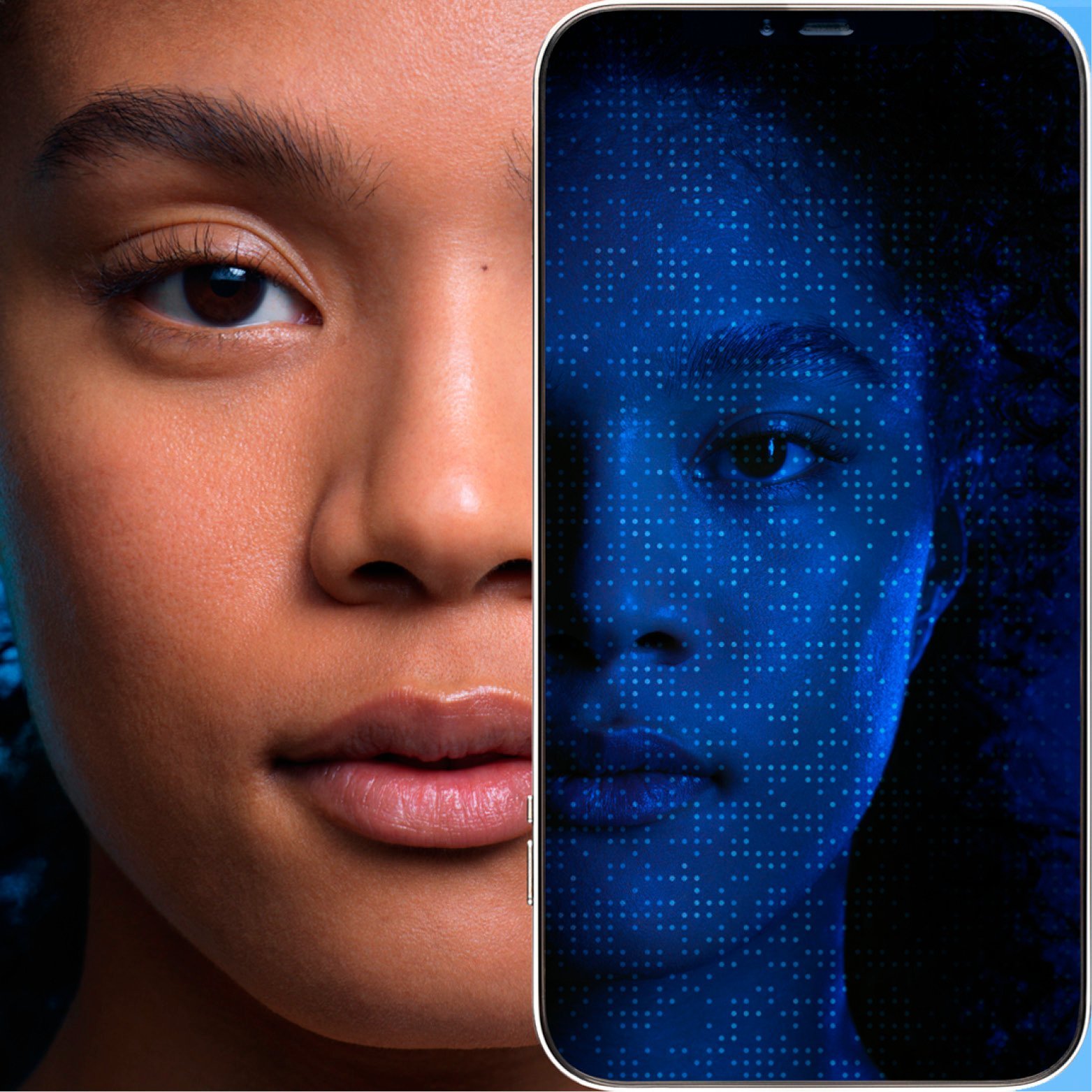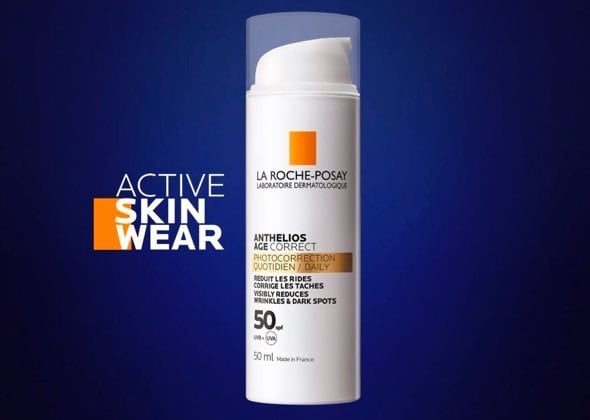What skin redness
looks like
Skin flushing and skin redness usually starts as faint redness across the nose and cheekbones but can worsen over time if not properly cared for. Years of sun damage can leave delicate, fair, and sensitive skin with permanent redness and visible blood vessels, particularly on the sides of the nose.
Redness has a significant impact on skin’s quality and characteristics. Not only is the skin tone less even; skin’s texture also becomes coarser. Skin redness is often associated with unpleasant sensitive skin signs such as itching, burning and stinging sensations. Click HERE to learn about solutions for sensitive skin. Many women with redness-prone sensitive skin are susceptible to facial flushing at times of stress or intense emotion.
Skin flushing and
skin redness causes
Skin redness has a number of causes. In many women, particularly those with fair, thin, or sensitive skin, redness is a sign of ageing brought on by years of sun exposure. Indeed, the sun is implicated in 27% of all cases of redness. In order to avoid the onset of new redness or aggravating already visible colour changes, effective sun protection is essential.
Other than the sun, skin flushing or skin redness can be brought on by a variety of other trigger factors that cause facial blood vessels to dilate:
- Stress or strong emotion (often manifesting as hot flushes).
- Sudden temperature or humidity changes (think hot showers on frosty mornings, or plunging into a cold pool after a steam).
- Hormonal changes can cause skin redness during pregnancy or menopause.
- Spicy foods, and stimulants like coffee.
- Alcohol (but having rosacea does not mean you are an alcoholic!).
- Smoking.
- Pollution.
- Vasoreactive skin can be a hereditary condition.
- Ageing – from age 25, skin becomes more prone to redness.
Who gets skin flushing or
skin redness and itching?
Only 11% of redness results from an underlying medical condition. Most commonly, skin redness is seen in people with a fair complexion and sensitive skin. Such skin has a particularly delicate surface barrier, leaving it vulnerable to UV radiation, irritants, and environmental factors.
When sensitive skin identifies an event or substance as an attack, alert signals are released in the form of inflammatory mediators like cytokines and histamine. These set off a chain reaction leading to vasodilatation, that is to say swelling of the skin’s network of blood vessels. This in turn can cause hot flushes, skin redness and itching.
Is my skin
redness permanent?
Skin flushing and skin redness usually starts out as temporary and diffuse. When your skin’s blood vessels dilate quickly, redness appears on the surface of your face: this is a flush. The vessels then return to normal. But if skin is not properly cared for, blood vessels can become more dilated over time and your skin can develop permanent redness or conditions such as rosacea.
The progression of redness can look like this:
- Temporary redness or “flushes”.
- Diffuse but permanent redness. This is called erythrosis, most commonly located on the cheeks.
- A worsening of erythrosis, with small visible vessels, also known as rosacea.
- Red spots (sometimes with whiteheads), which may then become inflammatory rosacea.
But don’t worry: With the right lifestyle tips and skincare routine, you can calm skin redness and stop it from getting any worse.
Tips on how to calm
skin flushing and skin redness
Looking and feeling red-faced can drain your confidence. Skin redness is not merely an imperfection that needs to be concealed. It is also a symptom of sensitive skin, calling for specific approaches to lifestyle and skincare.
- Avoid extremes of temperature: Shower or bathe in lukewarm water.
- Avoid spicy foods and stimulants such as tea and coffee.
- Keep alcohol consumption to a minimum.
- Protect skin from the sun every day, even in winter.
- Stop smoking.
- Simplify your skincare routine to avoid layering up multiple products.
- Use rosacea skincare or an anti redness moisturiser. Read on to find out more about skin redness treatments.
Taking care of skin redness
starts with the right skincare regime
Dermatologists recommend a specific skincare approach to stop redness from worsening and becoming permanent, yet only 1 out of 10 women with facial slushing and redness uses an anti-redness or rosacea skincare product.
Scroll down for our top skincare and procedure recommendations to calm skin flushing and skin redness.
A simple but effective routine
Since sensitive red skin can react to additives in the wrong skincare products, you should use a minimum number of products in your routine. Layering on 7 different serums and creams is a sure-fire way to guarantee a beaming complexion! Read on to discover which products are suitable for skin flushing and skin redness.
Cleanse gently to protect your skin’s natural surface barrier
If skin redness is an issue, soap and water are the last thing you want to use to cleanse your skin. This will strip it of its precious surface lipids, leaving it wide open to environmental attacks and even worse redness. Instead, opt for non-rinse products like MICELLAR WATER ULTRA Reactive Skin or TOLERIANE Dermo-Cleanser. Pat away grime and makeup with a soft cotton pad and don’t rub or scrub at your skin.
Soothe and calm your skin with anti-oxidant thermal spring water
After cleansing and before moisturising, fortify and soothe your sensitive skin with selenium-rich, anti-oxidant THERMAL SPRING WATER. Its prebiotic properties rebalance your skin’s microbiome to strengthen the natural barrier.
Top tip: A spritz of Thermal Spring Water spray is particularly effective to soothe skin redness after waxing or skin flushing after showering.
Hydrate your skin with an anti redness moisturiser or rosacea skincare
It’s essential to moisturise your skin, but many products contain irritants that can cause skin reactions and redness. ROSALIAC anti-redness moisturiser is the ultimate face redness reducer. Not only is it ultra-gentle, it also contains active ingredients that help fortify sensitive skin: Vitamin B3 stimulates your skin's natural defences against irritants, to eliminate redness and reduce blood-vessel reactions, whilst vitamin CG fortifies vessel walls by activating collagen synthesis. Finally, the smart anti-redness molecule Ambophenol acts on three levels:
- Anti-inflammatory and soothing to reduce redness.
- Microvascular protector to stop blood vessels from becoming visible.
- Anti-oxidant to protect skin cells from free radical attacks which can heighten redness.
Result? Day after day, skin’s redness is reduced, revealing the fresh and even complexion you once knew and loved.
BB and CC to the rescue!
Less is more when it comes to sensitive skin. That’s why BB and CC creams are friends to redness-prone skin: They combine multiple functions in a single formula, which reduces the chance of irritation. Plus, they come in light, spreadable textures to minimise friction.
ROSALIAC CC Creme corrects with proven anti-redness active ingredient Ambophenol, while instantly camouflaging redness with sheer pigments that strike the perfect balance between coverage and transparency.
ROSALIAC CC Creme also incorporates a hefty SPF30 to combat redness-prone skin’s worst enemy, the sun’s UV rays.
ANTHELIOS Ultra Tinted BB Cream SPF50+ is a very high protection, broad-spectrum cream that protects, moisturises, and unifies your complexion. Its universal micro-pigments adapt to every skin tone.
Use sun protection for sensitive skin, every day
Exposure to UV radiation is the primary cause of long-term skin redness. No matter the season, your face is exposed to the sun every day of the year. That’s why daily, broad-spectrum protection is a must-have for redness-prone skin. Make sure your sunscreen filters UVB, UVA, and long-UVA rays, which are present even in winter. ANTHELIOS Sun Intolerance SPF 50+ is designed for the most sensitive skin and eyes. It provides very high, broad-spectrum protection, and is enriched with soothing and anti-oxidant Thermal Spring Water.
Consider vascular laser treatments
A qualified dermatologist can recommend appropriate treatments to help reduce redness. When there are just a few highly visible vessels, electrocoagulation is an option. That involves administering a mild electric current via a small probe inserted into the skin. Vascular lasers also give excellent results. The KTP laser can greatly improve rosacea in 2 sessions spaced 6 weeks apart. Intense Pulsed Light (IPL) gives good results on erythro-rosacea. These treatments must be carried out at times when the skin is not exposed to the sun. Skin redness after laser treatment is usually transitory, lasting no more than a few days.
Top tip: You can calm skin redness after laser treatment with a spritz of Thermal Spring Water followed by an epidermal repair gel such as CICAPLAST Gel B5.
What if my skin redness
is due to allergies?
Allergic skin rashes are a key cause of redness
As we have explored, sensitive skin redness can be brought on by a host of internal and external factors. In the case of allergic skin, red skin rashes are brought on by specific allergens in our environment, cosmetics, food and medications. If itchy allergic skin rashes are a bugbear for you, you may wish to consider seeing an allergist to pinpoint your triggers. But specific skincare for allergic skin can help too: Gently cleanse allergic skin with a non-rinse micellar water or TOLERIANE Dermo-Cleanser to remove all allergens from its surface, followed by a spritz of naturally anti-inflammatory Thermal Spring Water, and finish up with an instantly soothing barrier cream tested on allergic skin such as TOLERIANE Ultra. Rest assured, skin flushing and skin redness due to skin allergies will be soothed in no time.
Is your skin sensitive, reactive, or allergic? Find out HERE.
Want to know more? Click HERE for a skincare routine for sensitive skin and HERE for a guide to make-up for sensitive skin.








